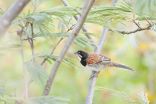(Press-News.org) LAWRENCE -- A wide-ranging study of gains and losses of populations of bird species across Mexico in the 20th century shows shifts in temperature due to global climate change are the primary environmental influence on the distributions of bird species.
"Of all drivers examined ... only temperature change had significant impacts on avifaunal turnover; neither precipitation change nor human impacts on landscapes had significant effects," wrote the authors of the study, which appeared recently in the peer-reviewed journal Science Advances.
Using analytical techniques from the field of biodiversity informatics, researchers compared current distributions with distributions in the middle 20th century for 115 bird species that are found only in Mexico. They then compared those bird community changes to patterns of change in climate and land use.
"We assessed which places appear to have lost which species," said lead author A. Townsend Peterson, university distinguished professor of ecology & evolutionary biology at the University of Kansas and senior curator at KU's Natural History Museum and Biodiversity Institute.
"We picked out places that were well-characterized with data," he said. "Once we did a dissection of what was lost where, we analyzed what could be be driving those changes. We got summaries of how much temperature, rainfall and land use had changed across the country, and that was a very interesting result because avifaunal changes were associated with temperature change only."
The researchers created detailed maps based on data about bird occurrences in Mexico from two key sources. More than 330,000 records of historical bird occurrences were drawn from the Atlas of Distributions of Birds of Mexico project collected mostly from 1920 to 1950.
"The historical data is pretty unique to Mexico," Peterson said. "It comes from specimens in natural history museums from around the world -- 64 museums everywhere from Russia to Mexico to KU. But we've spent years improving the data, adding geo-references, adding and checking identification and doing other checks to be confident in the data. The old 'Birds of Mexico' data set is pretty unique. There aren't very many countries that have that comprehensive a data set encompassing a major taxon like birds."
Peterson and his colleagues also considered 890,000 records of bird occurrences collected since 2000 by citizen scientists and deposited in the aVerAves database.
The researchers related the changes in bird populations to land-use patterns using the Global Human Influence Index, a data set that includes population density and other measures of people's influence on natural areas through land use, building, roads, nighttime lights and other factors. They also explored information captured by hundreds of weather stations documenting climate change across Mexico in the latter half of the 20th century, focusing on temperature and rainfall.
According to Peterson, the researchers suspected temperature fluctuations caused by global climate change would be a key driver determining bird community change in the temperate zone, but they were surprised that it was the prevailing factor in a tropical area like Mexico.
"Birds are making sure they have space and time and resources to carry out their life cycle -- the real name of the game is reproduction," he said. "In the temperate zone, birds are waiting until it's just warm enough to start the nesting cycle. They're timing breeding so they'll have young in nests right when they have maximum food available. But in the tropical world, it's always a pleasant temperature for birds, so I'd imagined precipitation might have had more of an effect."
Overall, among bird species endemic to Mexico, numbers of losses greatly outweighed gains, the study showed. The research found "relatively few" gains of species, mainly in the central-northern Chihuahuan Desert and in the northwestern Baja California along the border with the U.S. state of California.
Peterson said the findings should provide some useful information to Mexican environmental policymakers.
"When you design protected areas, like national parks or biospheres for biodiversity conservation, that design needs to take into account how climates are changing," he said. "They've done major planning, more than in the U.S., for present-day distributions of species. But climate change must be taken into account because those distributions are changing."
INFORMATION:
Peterson's co-authors were KU's Jorge Soberón; Adolfo G. Navarro-Sigüenza, Enrique Martínez-Meyer and Angela P. Cuervo-Robayo of the Universidad Nacional Autónoma de México; and Humberto Berlanga of the Comisión Nacional para el Conocimiento y Uso de la Biodiversidad.
URBANA, Ill. - A recent study looked at marijuana and alcohol use in people between the ages of 18 and 24. It's probably not surprising that the results show a drastic increase in alcohol consumption in people just over 21; after all, that's the minimum legal age to drink. What University of Illinois economist Ben Crost found remarkable is that, at the same age, there was an equally dramatic drop in marijuana use.
"Alcohol appears to be a substitute for marijuana. This sudden decrease in the use of marijuana is because they suddenly have easy access to alcohol," Crost ...
ATLANTA--Structural brain abnormalities in patients with schizophrenia, providing insight into how the condition may develop and respond to treatment, have been identified in an internationally collaborative study led by a Georgia State University scientist.
Scientists at more than a dozen locations across the United States and Europe analyzed brain MRI scans from 2,028 schizophrenia patients and 2,540 healthy controls, assessed with standardized methods at 15 centers worldwide. The findings, published in Molecular Psychiatry, help further the understanding of the mental ...
Researchers from the University of Houston found that some natural gas wells, compressor stations and processing plants in the Barnett Shale leak far more methane (CH4) than previously estimated, potentially offsetting the climate benefits of natural gas.
The study is one of 11 papers published in the July 7 edition of Environmental Science & Technology, all looking at fugitive methane emissions in the Barnett Shale. That region, site of the first widespread shale development in the United States, includes Dallas-Fort Worth and almost two dozen counties to the west ...
Effectiveness shown in tests on ovarian and bowel cancer
Drug can shut down a cancer cell's metabolism
Developed by researchers at the University of Warwick's Warwick Cancer Research Centre
Tests conducted by the Wellcome Trust Sanger Institute's Cancer Genome Project
New drug could be cheaper to produce and less harmful to healthy cells
Tests have shown that a new cancer drug, FY26, is 49 times more potent than the clinically used treatment Cisplatin.
Based on a compound of the rare precious metal osmium and developed by researchers at the University of Warwick's ...
Professor Richard Lilford and Dr Yen-Fu Chen of the University's Warwick Medical School, raised the issue following a study that states hospital weekend death risk is common in several developed countries - not just England
Professor Lilford, said: "Understanding this is an extremely important task since it is large, at about 10% in relative risk terms and 0.4% in percentage point terms. This amounts to about 160 additional deaths in a hospital with 40,000 discharges per year.
"But how much of the observed increase results from service failure? And here is the rub, ...
This news release is available in German.
Jülich, 7 July - Using a single molecule as a sensor, scientists in Jülich have successfully imaged electric potential fields with unrivalled precision. The ultrahigh-resolution images provide information on the distribution of charges in the electron shells of single molecules and even atoms. The 3D technique is also contact-free. The first results achieved using "scanning quantum dot microscopy" have been published in the current issue of Physical Review Letters. The related publication was chosen as ...
A yearlong study of first-time smartphone users by researchers at Rice University and the U.S. Air Force found that users felt smartphones were actually detrimental to their ability to learn.
The research paper "You Can Lead a Horse to Water But You Cannot Make Him Learn: Smartphone Use in Higher Education" appeared in a recent edition of the British Journal of Educational Technology. The research reveals the self-rated impact of smartphones among the users.
"Smartphone technology is penetrating world markets and becoming abundant in most college settings," said Philip ...
Today in Nature Communications, scientists at the Institute for Research in Biomedicine (IRB Barcelona) provide molecular details about Seckel Syndrome, a rare disease that causes microcephaly, or small brain, and growth delays. A joint study conducted by Travis Stracker and Jens Lüders indicates that the protein CEP63 plays a key role during brain development as it is involved in the correct division of stem cells in this organ. Furthermore, the researchers have discovered that CEP63 is associated with sperm production--an unknown function until now.
Rescuing microcephaly ...
This news release is available in Spanish. Mikel Zubizarreta, a member of the UPV/EHU's IT 781-13 group, highlights the advantages of timber in building works: "Although it is not as tough as other materials used in structures, it is a better insulator, in other words, it is more energy-efficient and less dense so the structure weighs less. On the other hand, timber is a renewable material -trees are planted and grown and forests are a CO2 sink- and is abundant in the Basque Country (nearly 55% of its surface area consists of forests)."
Yet timber is used much less ...
PHILADELPHIA - Many people believe that phase I trials with healthy volunteers are very risky and because they pose risks with no benefits, unethical. But how risky are such trials? Less than 1% of 11,000 healthy volunteers who participated in 394 phase I trials for new drugs experienced serious complications, according to a new meta-analysis of participants in non-cancer, phase I medication trials. In addition, none of the volunteers died or suffered persistent disabilities linked to the experimental drugs. In the largest study of its kind, researchers found only 34 (0.31%) ...



